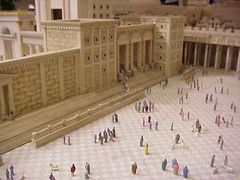 |
| Remains of a Roman bath complex in Herculaneum. Photo by Mharrsch. |
The excavations revealed several plastered bathtubs in the side of the pool, a pipe used to fill it with water, and a white industrial mosaic on the floor of the pool.
The bathhouse tiles, stamped with the symbols "LEG X FR" - Tenth Legion Fretensis - were found in place and the paw print of a dog which probably belonged to one of the soldiers was impressed on the symbol of the legion on one of the roof tiles. - More: News24.com
 Image by mharrsch via Flickr Image by mharrsch via Flickr |
| Model of the Temple in Jerusalem at the Holy Land Experience in Orlando, FL. |
The Legio X Fretensis ("Tenth legion of the sea strait"), had been stationed in Judea after the Great Jewish Revolt in 70 CE. Jewish unrest, however, continued to plague the Roman provincial government. Hostilities finally erupted again after Hadrian announced he would rebuild the Jews holiest city as a Roman metropolis, ploughing up the remains of Herod's temple (The Second Temple) and replacing it with a temple of Jupiter. The leader of the revolt, Simon bar Kokhba was thought to be a Jewish messiah and rebels announced the "era of redemption of Israel". Over 580,000 Jews were killed during the Bar Kokhba revolt (132–136 CE) and 50 fortified towns and 985 villages razed. Bar Kokhba as well as ten leading members of the Sanhedrin were executed and thereafter Hadrian prohibited Torah law and the Hebrew calendar.
 Image by mharrsch via Flickr Image by mharrsch via Flickr |
| Portrait sculpture of the Roman Emperor Hadrian found at Tivoli |
Modern historians have come to view the Bar-Kokhba Revolt as being of decisive historic importance. The massive destruction and loss of life occasioned by the revolt has led some scholars to date the beginning of the Jewish diaspora from this date. They note that, unlike the aftermath of the First Jewish-Roman War chronicled by Josephus, the majority of the Jewish population of Judea was either killed, exiled, or sold into slavery after the Bar-Kokhba Revolt, and Jewish religious and political authority was suppressed far more brutally. After the revolt the Jewish religious center shifted to the Babylonian Jewish community and its scholars. - Bar Kokhba's Revolt, Wikipedia




























